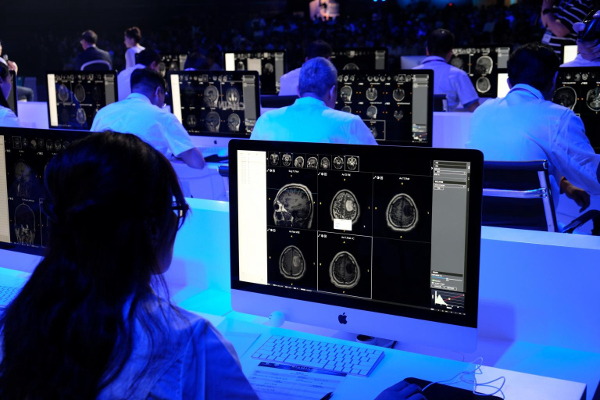Artificial intelligence (AI) and machine learning are driving growth in medical imaging, with deep-learning applications being integrated with radiology for faster and higher-precision diagnosis. Algorithms mine raw data sets within seconds to classify and detect aberrations by reading images at efficiencies that humans can’t match.
Even so, errors do happen in AI diagnoses. Now a clutch of innovators in India are developing solutions that are making AI-based image diagnostics more accurate and helping resolve complex cases in a fraction of the time taken by clinicians.
One such innovator is Dr Vidur Mahajan, who heads a team of young scientists, doctors and coders at Centre for Advanced Research in Imaging, Neuroscience and Genomics (Caring) at Mahajan Imaging in New Delhi. They are working with global partners – research, acadaemia and industry — to help modify machines to always get it right. The team’s latest project ready for market pending FDA 510(k) approval is GE Healthcare’s Critical Care Suite, which has an AI that screens X-rays for pneumothorax (collapsed lung) and sends automated notification to the technologist/radiologist when there is a suspected critical finding.
“CARING helped brainstorm what the product definition should be and helped mark out pneumothorax on a very large dataset of about 6,000 chest X-Rays. The clinical team dove deep into the performance of the AI algorithm to identify patterns and figure out why the algorithm was failing in certain cases,” said Dr Mahajan, head of research and development at Caring.
Running extensive tests showed the AI was falsely marking chest tubes and mach-bands (false shadow) as pneumothorax, leading to false positives. “Based on our feedback, the AI scientists at GE modified their algorithm. What’s notable is product was taken from concept to regulatory application in less than one year,” said Mahajan, who co-authored a study on deep-learning algorithms for detection of critical findings in head CT scans that was recently published in the journal The Lancet.
This new technology assists clinicians to prioritise results that need immediate review, so that the patient gets immediate treatment faster, resulting in better outcomes, reduced costs and improved patient experience.
The global market for machine learning in medical imaging, comprising software for automated detection, quantification, decision support and diagnosis, is expected to cross $2 billion by 2023, according to Signify Research, an independent supplier of market intelligence on global healthcare technology industry.
“We are working to integrate AI into every aspect of patient care. Digital health and AI have immense potential to positively impact accuracy of medical diagnosis, efficiency of clinicians, personalization of treatment and improving patient outcomes around the world. It can help us achieve the triple aim — improved health outcome for populations, better patient experience and reduced costs—the Holy Grail of healthcare today,” said Nalinikanth Gollagunta, president and CEO, GE Healthcare, South Asia.
CARING’s also using its AI-integration platforms to deploy a chest x-ray AI system across three imaging centres to assess performance in real-world clinical settings. “The validation process involves re-reading all the cases where there is discordance between AI and radiologists to help developers decode where and why their algorithm fails,” said Mahajan.
AI’s higher efficiency that allows radiologists to perform more value-added tasks, such as customising the patient’s diagnosis and treatment, say experts. Apart from image processing and interpretation, AI applications include image acquisition and processing to aided reporting, follow-up planning, data storage, and data mining, among many others.
“Even if AI misses some readings, it will still outperform radiologists. And just as we need second opinions and other appropriate interventions to correct human error, we need reliable deep-learning tools to monitor algorithms to always get it right.,” said radiologist and AI-researcher Dr Vasanth Venugopal.
Applying these deep-learning based tools, many of which are available free, to raw data in radiology is critical not just in India but around the world, where a human resources shortfall and a bludgeoning ageing population is increasing pressure on existing health services, which affects clinical outcomes.
Source: HS
Image Courtesy: Medium
You may also like
-
New Heat-Based Approach To Cancer Treatment Can Reduce Chemotherapy Doses
-
Scientists Take A Major Step Towards Unification Of Classical & Quantum Gravity
-
India Graphene Engineering and Innovation Centre (IGEIC) Under the Vision of Viksit Bharat@2047 Launched
-
New High-Performance Gas Sensor can Monitor Low Level Nitrogen Oxides Pollution
-
Antidepressant Drug can be Repurposed for Treating Breast Cancer
